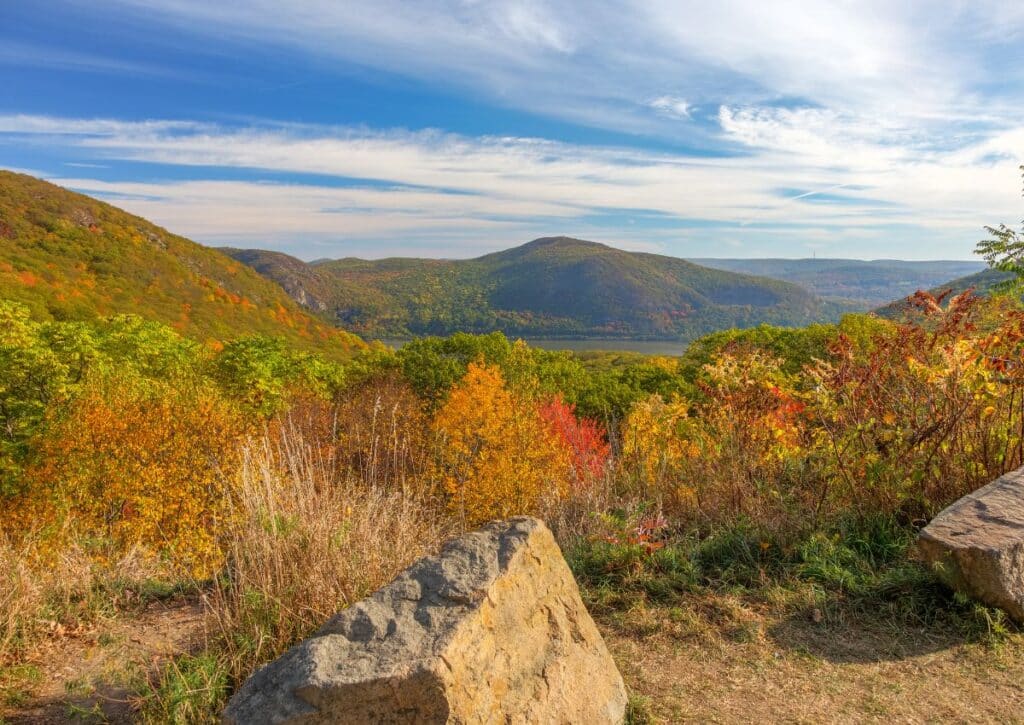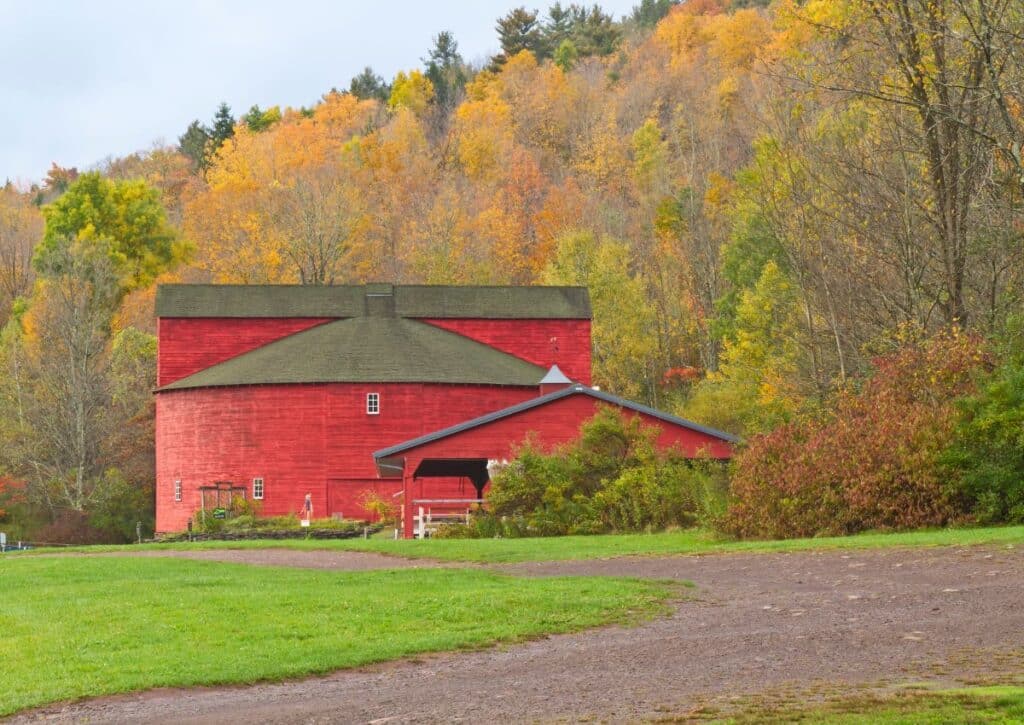Explore what type of Landscape the Catskills are in this comprehensive travel guide, covering rugged mountains, lush forests, and abundant wildlife
The Catskills are a series of mountain ranges located in southeastern New York, characterized by forested peaks, cascading waterfalls, and vast wilderness areas. It’s a landscape formed from ancient geological processes, a sanctuary away from urban hustle.
Located in southeastern New York, this region encompasses over 6,000 square miles of rugged mountains and verdant forests.
Easily accessible from major cities, the Catskills provide an ideal setting for outdoor activities like hiking, fishing, and camping.
Why the Catskills? With over 35 peaks surpassing 3,500 feet and hundreds of miles of trails, it’s a prime location for avid hikers.
The area is also home to diverse wildlife and several pristine lakes and rivers, making it not just a destination for elevation but also for nature immersion. An optimal choice for a genuine nature getaway.
Let’s dive in to unravel this diverse adventure hotspot.
Geographical Overview
The Catskills, spread over 6,000 square miles, is not your typical mountain range. In fact, it’s a dissected plateau, meaning it was formed not by land uplift but by erosion carving out valleys and peaks from a flat region.
This geological marvel took shape around 375 million years ago.
Now, if you’re mapping your journey, note that the Catskills house over 35 peaks that rise above 3,500 feet. Slide Mountain reigns supreme at 4,180 feet, making it the tallest in this range.
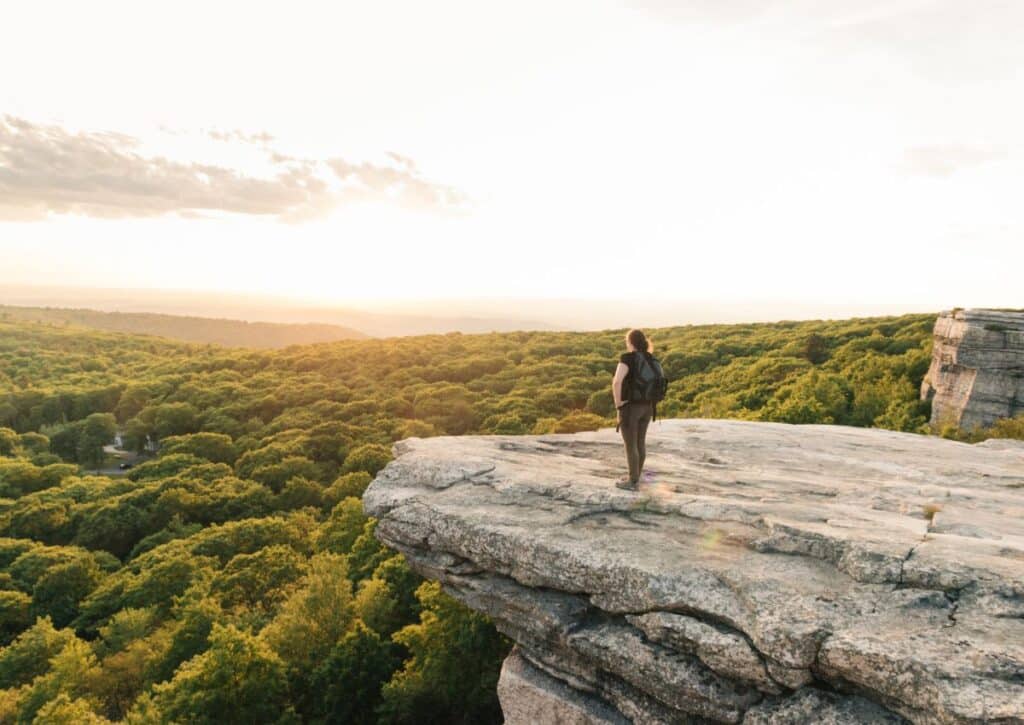
A treasure for hikers, indeed! The region also boasts about 300 miles of multi-use trails, offering both gentle walks and challenging terrains.
Water bodies? The Catskills doesn’t disappoint. It’s home to numerous reservoirs, and streams, including the famous Esopus Creek, known for its fly-fishing spots.
The forests are predominantly deciduous with species like maple, oak, and beech covering vast expanses, interspersed with conifers in cooler, higher altitudes.
Planning a trip here? Whether you’re an adventurer, a nature lover, or someone in between, the varied landscape of the Catskills ensures there’s something for everyone.
Wilderness Areas in the Catskills
The Catskills region is not just about peaks; it’s also a sanctuary of sprawling wilderness areas.
These areas, preserved in their natural state, offer untouched beauty and are crucial habitats for various species.
If you’re aiming to explore the heart of Catskills’ nature, these wilderness spots are must-visits.
Lets briefly explore 9 of our favorite wilderness areas we have covered over the last 2 decades.
Slide Mountain Wilderness
Spanning over 47,500 acres, the Slide Mountain Wilderness is the largest and one of the most distinguished wilderness areas within the Catskills.
Dominated by the prominent Slide Mountain, which stands at 4,180 feet, this wilderness area boasts the highest peak in the entire Catskills range.
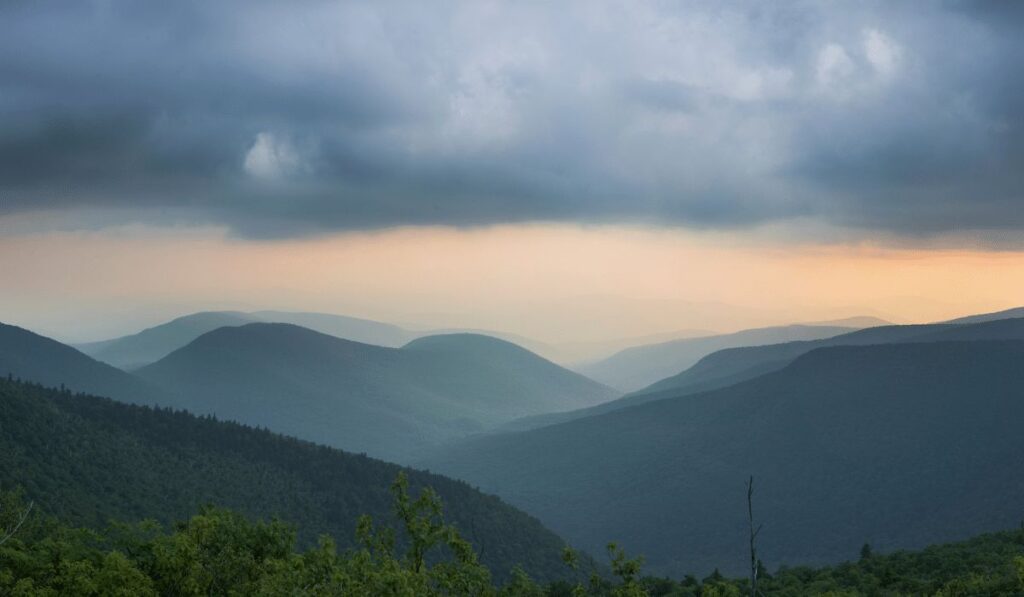
The topography of the area is rugged, characterized by steep, craggy slopes and dense forest cover.
As you traverse its landscape, you’ll notice a mix of hardwood forests at lower elevations and coniferous trees, like spruces and firs, as you climb higher, a unique trait not commonly seen elsewhere in the Catskills.
Wildlife enthusiasts? Be on the lookout! The region is home to species like black bears, bobcats, and white-tailed deer. Birdwatchers might spot the elusive Bicknell’s Thrush, especially near the mountain’s summit.
For the avid hikers, the Slide-Cornell-Wittenberg Trail is a popular choice, spanning roughly 9.8 miles and offering panoramic views from multiple peaks.
But if you’re looking for shorter excursions, the Slide Mountain Loop is about 5.4 miles and takes you directly to the highest Catskills’ summit.
Outdoor activities here are not just limited to hiking. Winter introduces snowshoeing and backcountry skiing opportunities, while warmer months are perfect for bird-watching and nature photography.
There are several designated campsites along the trails, with the most popular ones near the summit of Slide Mountain.
But remember, camping above 3,500 feet is restricted from March 21 to December 21 to protect the fragile environment.
Exploration Tips: Always check weather conditions before embarking on hikes, especially in higher altitudes.
If you’re hoping to catch a serene sunrise or sunset, Slide Mountain’s summit is the place to be, but ensure you’re well-equipped for the descent in low light.
Carry a map and compass; while the trails are generally well-marked, it’s always safer to be prepared.
Indian Head Wilderness
At over 11,500 acres, the Indian Head Wilderness offers a rugged and picturesque landscape, marked by challenging terrains and panoramic views. The area is named after the Indian Head Mountain, a distinctively shaped peak.
Topographically, the region boasts rocky outcrops and narrow valleys. The forest composition changes with elevation, presenting a diverse mix of deciduous and coniferous species.
Wildlife sightings include black bears, raccoons, and various songbirds. If you’re lucky, you might even spot a bald eagle soaring overhead.
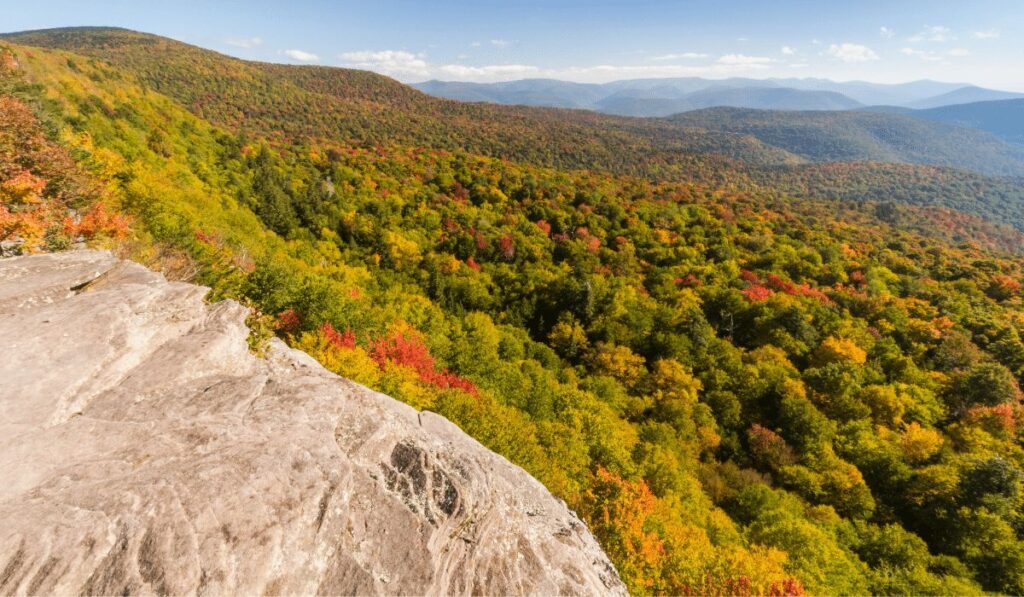
The Devil’s Path, stretching approximately 25.2 miles, is one of the most challenging hikes in the Eastern US and runs through this wilderness. Shorter trails like the Jimmy Dolan Notch Trail, around 3.8 miles, offer a slightly less strenuous option.
Besides hiking, rock climbing is a popular activity in the region, especially around the Twin Mountain and Sugarloaf Mountain areas.
Several primitive campsites are scattered throughout, but note that fires are prohibited in the Indian Head Wilderness to minimize human impact.
Tips: The Devil’s Path is not for the faint-hearted. If attempting, ensure you’re well-equipped and physically prepared.
Big Indian Wilderness:
Covering more than 33,000 acres, the Big Indian Wilderness is a tranquil retreat characterized by dense forests, pristine streams, and a variety of terrains.
The topography here offers gentle slopes intermixed with steep inclines, leading to picturesque valleys.
The region’s forests are predominantly hardwood, interspersed with hemlock stands near water sources.
Among the fauna, look out for river otters in the area’s many streams and the occasional sighting of a coyote or fisher.
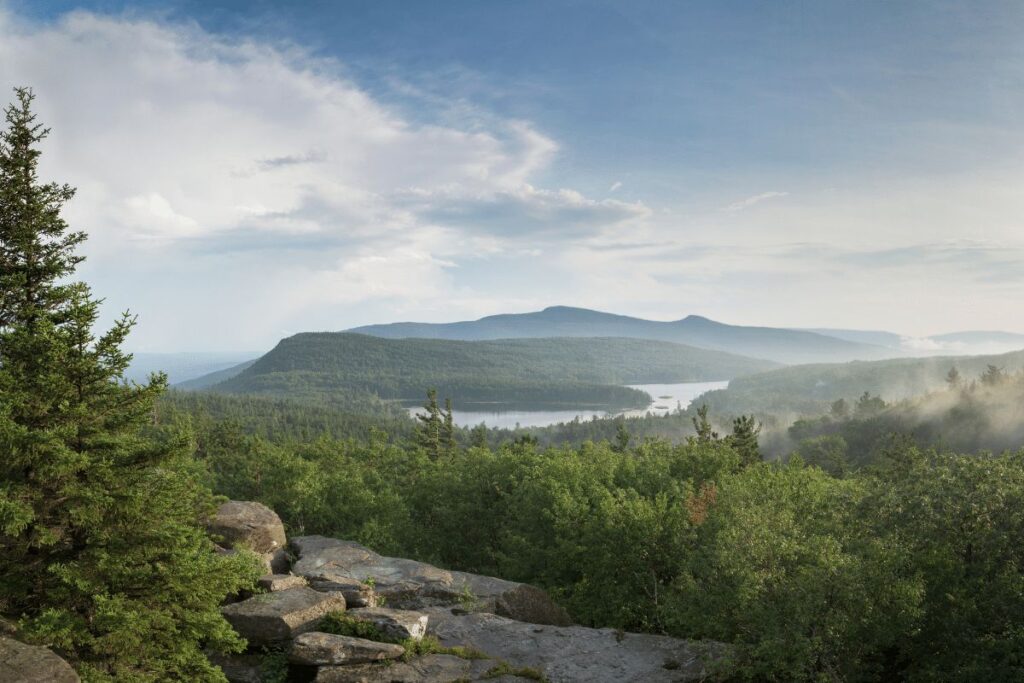
The Pine Hill-West Branch Trail is a key attraction, running for about 15.7 miles across the wilderness. For a shorter hike, the Seager-Big Indian Trail, which covers 6 miles, offers a fulfilling experience.
The area provides opportunities for fishing in its streams, especially brook trout. Designated campsites can be found at regular intervals, with some near major trailheads.
Tips: The water bodies are inviting but always treat water before consumption. Be bear-aware; while they are usually elusive, it’s good to take precautions.
Shandaken Wild Forest
Spanning 53,000 acres, Shandaken is more accessible and tends to be more populated than other wilderness areas in the Catskills, thanks to its extensive network of trails and water bodies.
Its landscape is a blend of rolling hills, vast forests, and waterways. You’ll find a diverse mix of tree species, from maples and oaks to white pines.
Common wildlife includes beavers, known for their dams in the region’s streams, and wild turkeys.
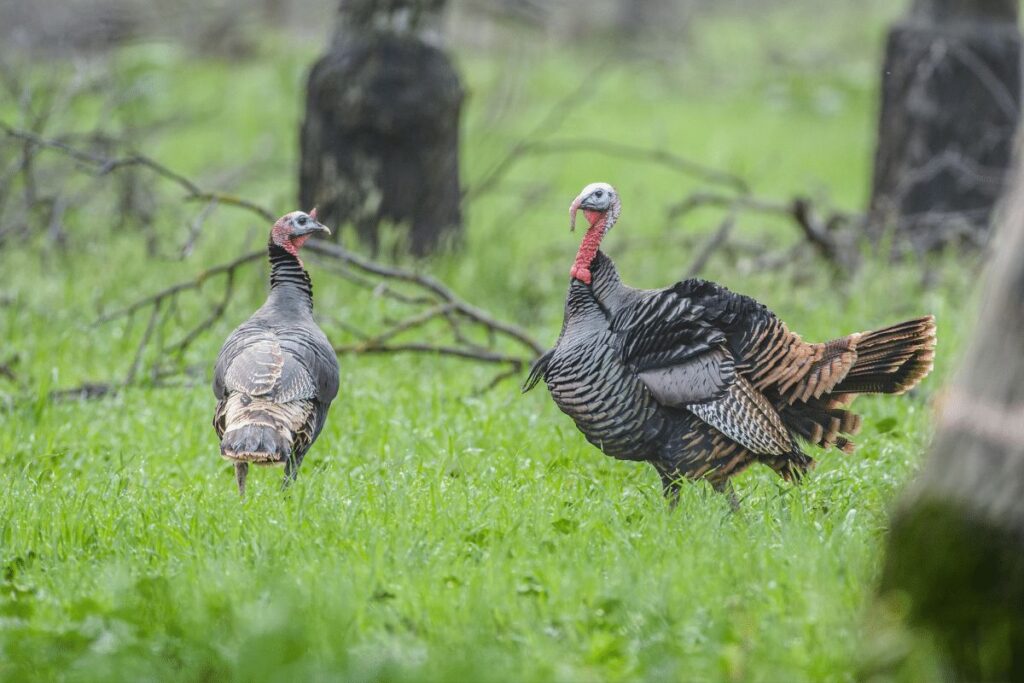
The Giant Ledge-Panther Mountain Trail, at 7.1 miles, offers stunning views, making it a favorite among hikers. Phoenicia East Branch Trail, about 6 miles long, is another popular choice.
Kayaking and canoeing enthusiasts frequent the Esopus Creek, and during winters, the area transforms into a playground for snowmobilers.
There are multiple designated camping areas, some accessible by vehicle, making it a good choice for those less inclined to backpack their gear.
Tips: Due to its popularity, some trails can get crowded. Opt for weekday visits for a quieter experience. Also, if you’re kayaking in the Esopus, be aware of water release schedules from the Shandaken Tunnel.
Windham-Blackhead Range Wilderness:
Covering an impressive 16,500 acres, the Windham-Blackhead Range Wilderness stands out as a testament to the Catskills’ rich geological history and mesmerizing beauty.
This expanse is crowned by the likes of Blackhead, Black Dome, and Thomas Cole mountains, marking a trail frequented by peak-baggers.
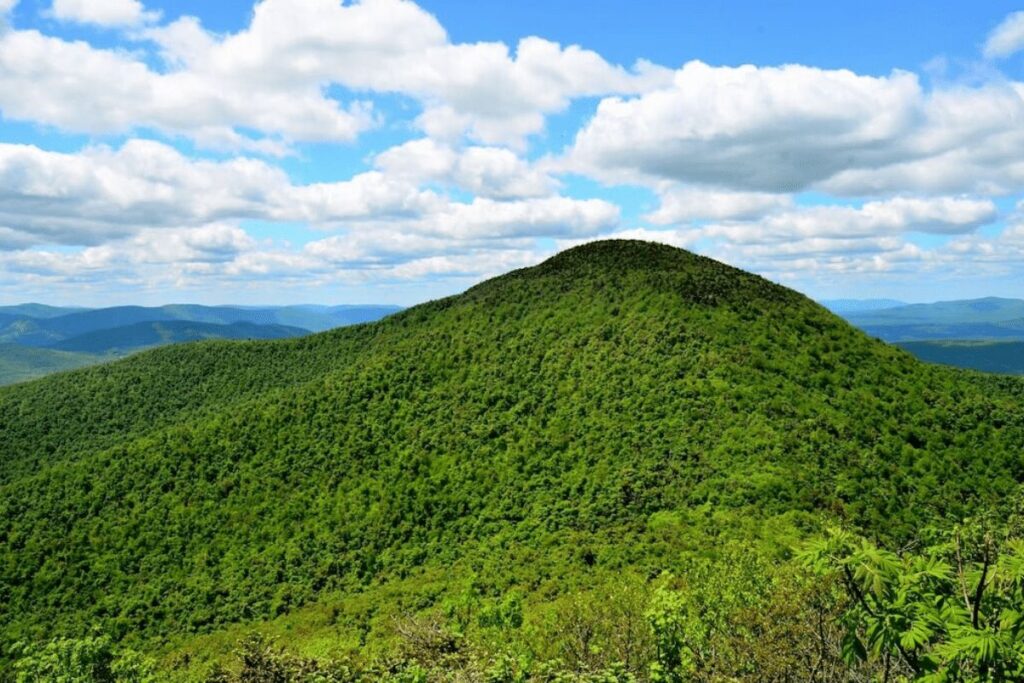
Its physical landscape is a challenge to the unprepared: from valleys echoing with trickling streams to steep, rugged ascents, demanding the very best of those who trek here.
Initially, hikers wade through lush hardwood forests, but as the trail inches upwards, these give way to the aromatic and stately evergreens.
As for wildlife, it’s a thriving hub. Porcupines nibble at tree barks, white-tailed deer dart through the underbrush, and black bears — the true kings of these woods — lumber around, searching for their next meal.
For avian enthusiasts, the circling raptors above offer a delightful sight.
Trail-wise, the 23-mile-long Escarpment Trail reigns supreme, weaving through several of the high peaks and challenging even the most seasoned hikers. A direct ascent? The 4.3-mile Blackhead Mountain Trail won’t disappoint, leading straight to panoramic vistas.
Beyond hiking, the winter transforms this wilderness into a snowy wonderland, perfect for snowshoeing and skiing.
Those looking to camp will find Battie Louie Hollow a peaceful resting spot, though remember to pack in ample water for the ascent.
Tips: ascend with enough water, be wary of black bears, and always be prepared for quick weather shifts.
West Kill Mountain Wilderness
Stretching over 19,250 acres, West Kill Mountain Wilderness is like stepping into a Catskills postcard.
With West Kill Mountain itself piercing the sky at 3,880 feet, the region serves as a beacon for adventurers far and wide.
Its topography is a mosaic: think plateaus dotted with wildflowers, streams that whisper stories of old, and the majestic Diamond Notch Falls, especially arresting after a downpour.
Wildlife here is abundant and varied. Bobcats tread softly, their keen eyes scanning for prey, fishers dart about, and if you’re patient, you might even spot the Northern Goshawk taking flight.
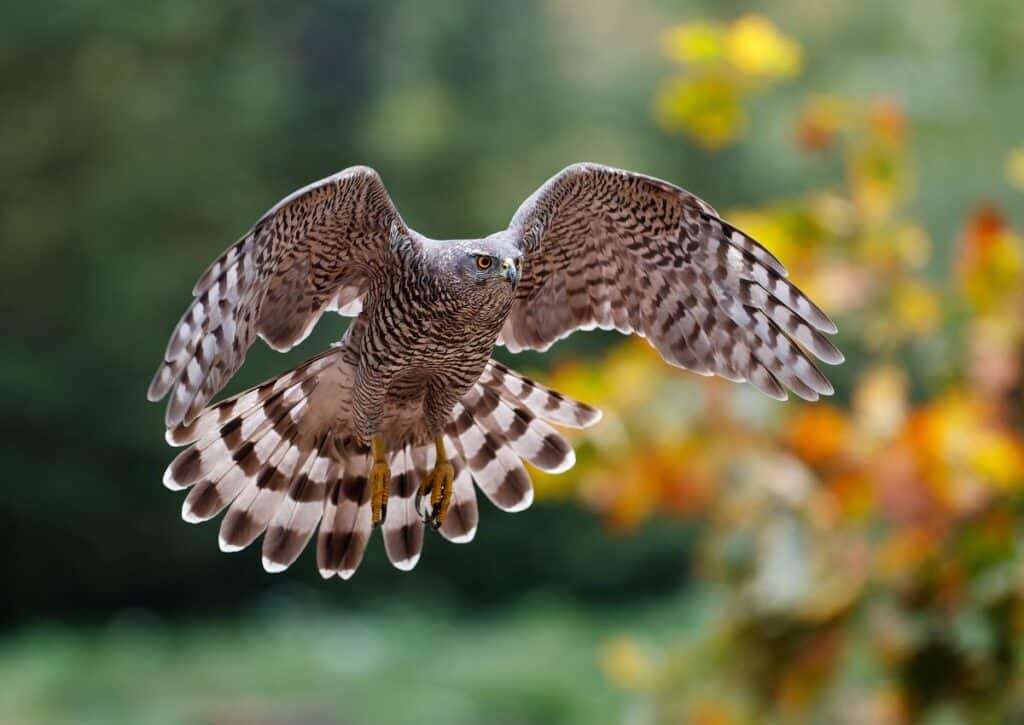
The streams, meanwhile, hold a special lure for anglers, with brook trout challenging their skills.
In terms of trails, the Devil’s Path is a rite of passage for many, with its rigorous terrain and unmatched views.
Alternatively, the Diamond Notch Trail, spanning 6.7 miles, offers a less strenuous but equally rewarding journey, culminating in the stunning waterfall.
For the icy months, specific cliff sections of this wilderness beckon ice-climbers, while the remaining snowy expanse proves ideal for snowshoeing.
As the day comes to an end, camping spots near Diamond Notch Falls offer serenity and starlit skies.
To round off, remember: the weather here is notoriously fickle, so pack layers. Anglers, ensure your New York State fishing license is in order, and as always, leave no trace. Safe travels!
Rusk Mountain Wild Forest
Covering a moderate expanse of 10,000 acres, the Rusk Mountain Wild Forest offers a secluded slice of the Catskills for those looking to veer off the beaten path.
At the heart of this wild forest stands Rusk Mountain, reaching an altitude of 3,680 feet, and serving as a non-official member of the Catskills’ 35 high peaks.
As one ventures into its depths, a mix of hardwoods and evergreen forests greets the eye, a bio-diverse haven transitioning seamlessly as altitudes vary.
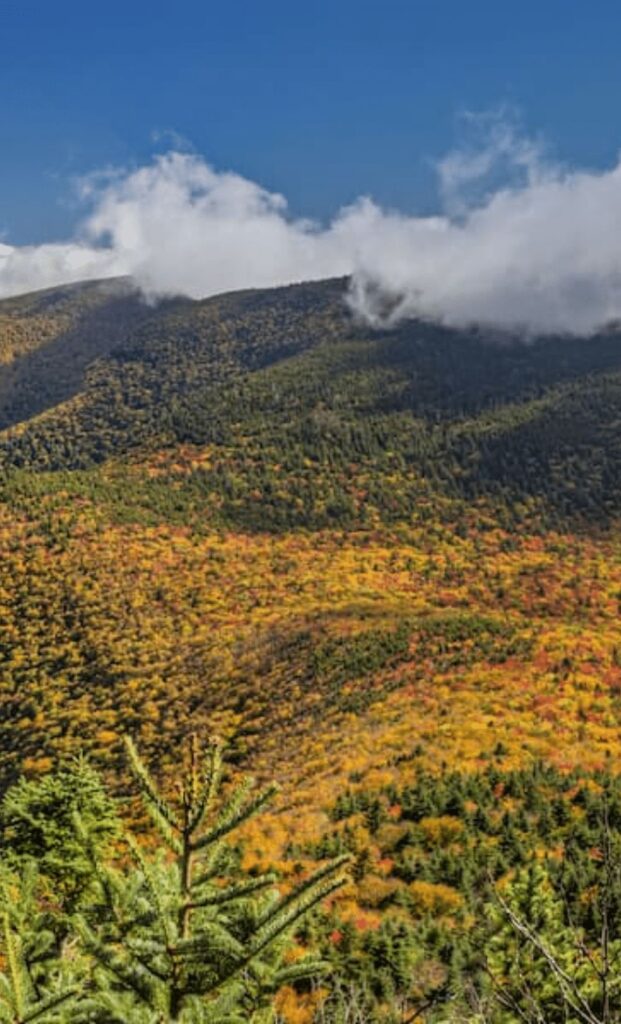
The region’s lack of marked trails makes it an allure for those craving adventure, with bushwhacking being a common way to explore.
The wildlife here is as varied as the landscape. From the playful antics of river otters in streams to the silent grace of white-tailed deer and the occasional glimpse of a coyote, it’s a nature lover’s dream.
For bird watchers, there’s no dearth of species to spot, with woodpeckers, warblers, and the striking scarlet tanager being regulars.
Popular treks include the unmarked journey to the Rusk Mountain’s summit, a challenging route requiring compass skills.
While camping is allowed, it’s essential to follow the at-large rules, setting up at least 150 feet away from water sources and trails.
And a tip for the intrepid traveler: always be prepared with a map and compass, as this wild forest truly is ‘wild’.
Sundown Wild Forest
Spanning an impressive 30,100 acres, the Sundown Wild Forest stands as a vast expanse of pristine Catskills terrain, inviting travelers to a more serene, less frequented part of the region.
Key features here include the Ashokan Reservoir’s northern touchpoints and a chunk of the Peekamoose Mountain and Table Mountain range.
Topographically, it’s a blend of rolling terrains, flowing streams, vast plateaus, and dense forest canopies.
As you hike, you’ll encounter deciduous trees like maples and oaks at lower elevations, gradually giving way to hemlocks and pines higher up.
The wild forest is a thriving habitat for diverse fauna. Black bears make their presence known with occasional sightings, wild turkeys strut through the underbrush, and beavers industriously build in the waterways.
Among the trails, the Peekamoose-Table Mountain Trail is a standout, offering about 10 miles of moderate to challenging terrains and stunning viewpoints.
In the warmer months, the Blue Hole, a renowned swimming spot, becomes an oasis for those seeking refreshment.
For those camping overnight, designated sites dot the area, but following the principle of ‘Leave No Trace’ is paramount.
Travelers, remember: while the Sundown Wild Forest might be quieter than other parts of the Catskills, it’s rich in beauty and deserves the utmost respect.
Willowemoc Wild Forest
The Willowemoc Wild Forest paints a sprawling canvas of approximately 14,800 acres within the Catskills, an expanse echoing with whispers of old tales and vibrant natural beauty.
It’s anchored by the legendary Willowemoc Creek, celebrated among anglers for its abundance of brown and brook trout.
Navigating this territory, one encounters a diverse landscape. Gently rolling hills transition to steep inclines, while dense hardwood forests of oak, maple, and birch make way for stretches of fragrant conifer stands in higher terrains.
This mosaic of topographical elements makes it an ideal backdrop for varied outdoor activities.
Wildlife in Willowemoc is a spectacle. Beyond the ubiquitous trout in its streams, the region is home to mammals like raccoons, white-tailed deer, and the occasional black bear.
Birdwatchers would delight in spotting species such as the barred owl, red-tailed hawks, and the vibrant indigo bunting.
Trail enthusiasts have a handful of options. The Mongaup-Hardenburgh Trail, extending about 10 miles, is a favored choice, winding through diverse terrains and offering ample photo opportunities.
The forest also stands out for its camping prospects. With multiple designated campsites available, it’s easy to find a quiet spot beneath the stars. But if fishing is your calling, always ensure you’re equipped with a valid New York State fishing license.
A word to the wise: While the Willowemoc Wild Forest might offer a serene escape, always tread with respect. Be it keeping a safe distance from wildlife or adhering to fishing regulations, remember that preserving its splendor is in the hands of each visitor.
Peaks That Rule the Catskills Landscape
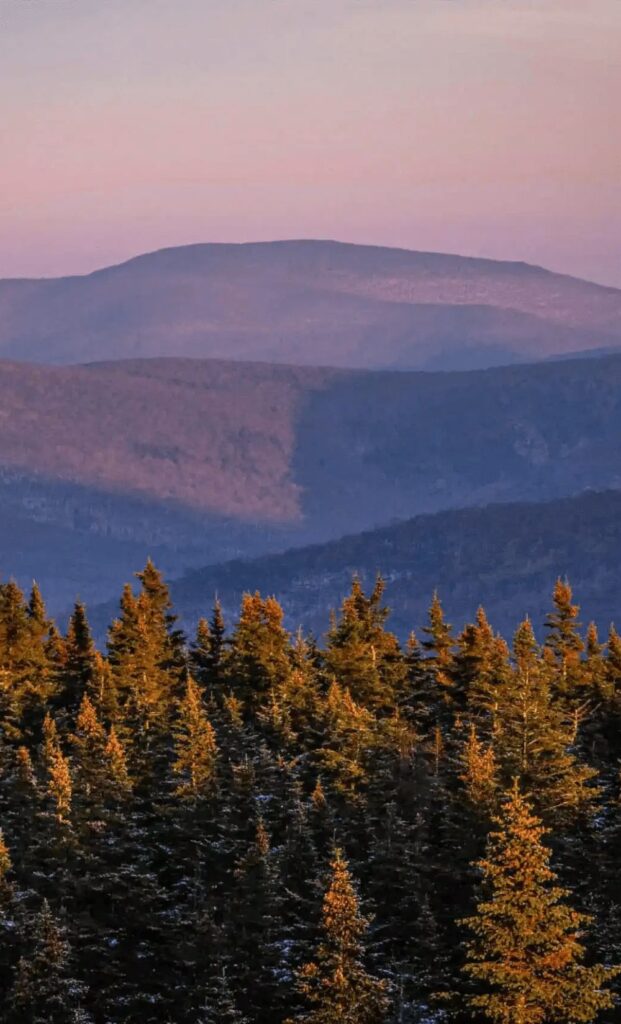
The Catskill Mountains, often referred to as the “Catskills,” stand as a rugged testament to nature’s timeless artistry.
With 35 official high peaks exceeding 3,500 feet in elevation, the Catskills offer a symphony of topographical wonders, from windswept summits to forest-clad slopes.
Here, we dive into a few of these iconic peaks:
Slide Mountain:
Elevation: 4,180 feet
Notable for: Being the highest peak in the Catskills.
Unique Aspect: Its mix of hardwood and coniferous forests that line the ascent, offering an ever-changing tableau to hikers.
Hunter Mountain:
Elevation: 4,040 feet
Notable for: Hosting a fire tower at its summit, providing panoramic views.
Unique Aspect: Home to the historic Hunter Mountain Fire Tower, the second-highest in the state.
Blackhead Mountain:
Elevation: 3,940 feet
Notable for: Its challenging trails, especially during winter.
Unique Aspect: The summit offers spectacular views of the northern Catskills and, on clear days, the Adirondacks and Green Mountains.
Table Mountain:
Elevation: 3,847 feet
Notable for: Being part of the popular Peekamoose-Table Mountain trail.
Unique Aspect: The plateau-like summit, giving it its table-like name, and the nearby Blue Hole—a popular swimming spot.
Cornell Mountain:
Elevation: 3,860 feet
Notable for: Its proximity to Slide and Wittenberg mountains, making it part of a popular hiking loop.
Unique Aspect: Known for the challenging ‘Cornell Crack,’ a steep rock scramble requiring hands-on navigation.
For adventurers, each peak in the Catskills is a unique journey. They challenge and enthrall, demanding respect for their rugged terrains.
But in return, they offer panoramic vistas, moments of solitude, and the pure, unadulterated beauty of the great outdoors.
When preparing to conquer these peaks, ensure you’re well-equipped and well-informed.
While the Catskills might not boast the altitudes of some other mountain ranges, they are by no means a walk in the park. Respect the terrain, be aware of the local wildlife, and always practice the principle of ‘Leave No Trace’.
Whether you’re a seasoned hiker, a casual trekker, or someone simply in awe of majestic mountains, the Catskills’ peaks stand waiting, promising experiences that linger long after the descent.
Wildlife You Will Encounter While Exploring the Catskills
The Catskills are more than just a stunning assortment of peaks and forests; they are a pulsating ecosystem, teeming with a myriad of wildlife that adds to the region’s profound charm.
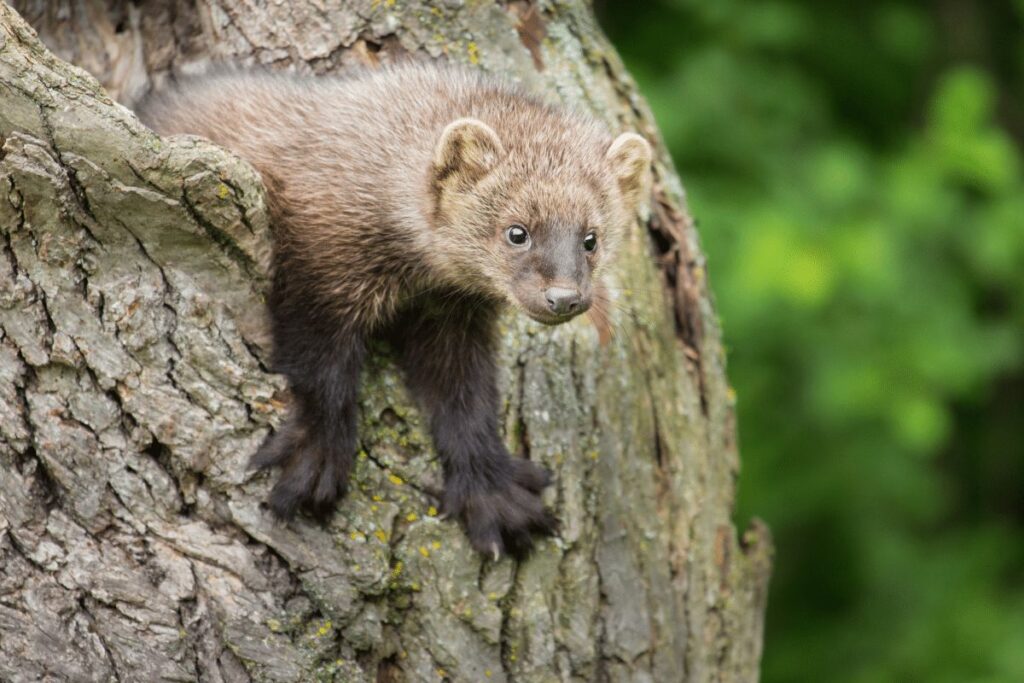
Venturing through its woods and trails, here’s what you might encounter:
Mammals:
Black Bears: The Catskills are home to a healthy black bear population. While sightings are a thrill, always keep a safe distance and never feed them.
White-tailed Deer: Commonly spotted in meadows and at the forest’s edge during dawn and dusk.
Bobcats: These elusive predators primarily roam the region’s remote areas.
Beavers: Especially active around the Catskills’ many streams and ponds, their dams are often visible.
Birds:
Bald Eagles: With the recovery of their populations, these majestic birds can be seen soaring over the region, especially around water bodies.
Bicknell’s Thrush: A rare species, primarily found in higher altitudes with thick spruce-fir forests.
Red-tailed Hawks: Frequently seen circling in the skies, they’re a testament to the region’s thriving ecosystem.
Barred Owls: Recognizable by their distinctive “who-cooks-for-you” call, especially during the night.
Reptiles and Amphibians:
Eastern Timber Rattlesnakes: Though rare, they can be found sunning on rocks. It’s essential to be cautious and avoid interaction.
Eastern Newts: Commonly spotted in moist habitats, these small, orange salamanders are a delight to observe.
Fish:
Brook Trout: Native to the Catskills, they thrive in the region’s cool, clean waters.
Brown Trout: Introduced to the area, they’ve now become a popular catch among anglers.
Insects:
Monarch Butterflies: Witness their breathtaking migration, especially during late summer and early fall.
Fireflies: Their bioluminescent dance on warm summer nights creates a magical atmosphere.
When exploring the Catskills, it’s important to remember that you’re stepping into the home of countless creatures. Observing wildlife is one of the purest joys of nature, but it’s crucial to do so responsibly. Avoid feeding wild animals, maintain a safe distance, and tread lightly to ensure these habitats remain undisturbed for generations to come.
With a keen eye and a bit of patience, the Catskills offer a window into the fascinating world of North American wildlife, each encounter making your journey all the more memorable.
Hiking in the Catskills Landscape
The Catskills, with their sprawling forests, rugged peaks, and gushing waterways, beckon hikers of all expertise levels.
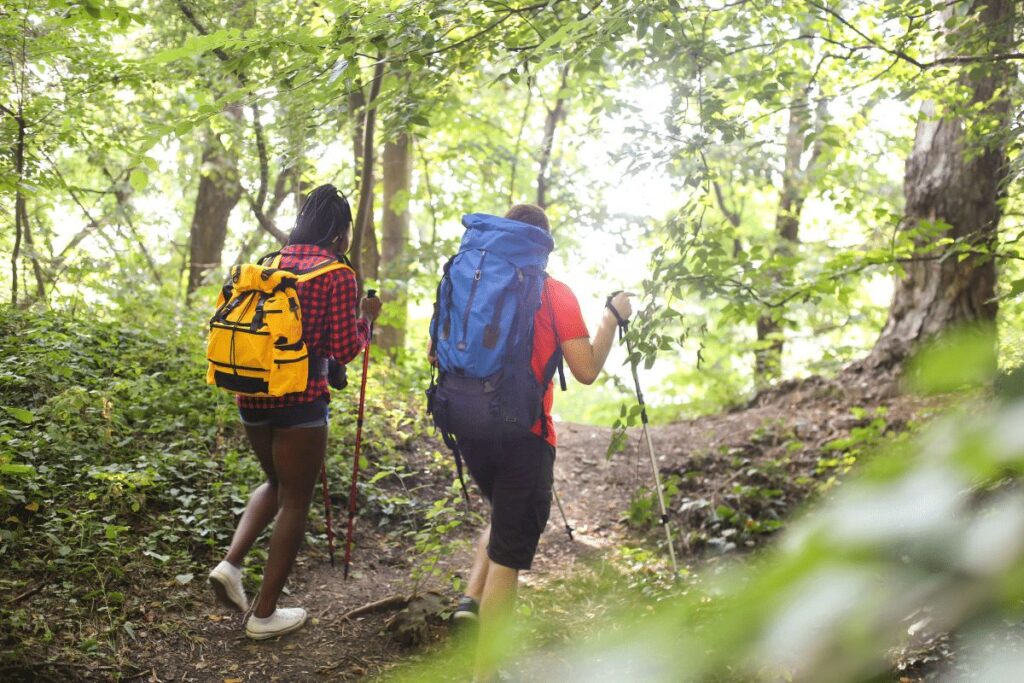
The region’s hiking trails not only provide a physical challenge but also offer a soulful journey into nature’s magnificence. Here’s what you need to know when embarking on a hiking adventure in the Catskills:
Trail Diversity:
Beginner Trails: For those new to hiking or looking for a relaxed trek, trails like the Ashokan Reservoir Promenade and the Kaaterskill Falls Viewing Platform are ideal. They offer stunning vistas without intense elevation changes.
Intermediate Trails: The North Point Loop or the Giant Ledge are excellent options. These offer a moderate challenge and lead to rewarding panoramic views.
Expert Trails: For seasoned hikers, trails like the Devil’s Path or the ascent to Slide Mountain promise steeper inclines, rock scrambles, and the thrill of conquering the Catskills’ highest terrains.
Seasonal Considerations:
Spring: As snow melts, trails can be muddy. Waterproof footwear is recommended. Watch for blooming wildflowers!
Summer: Popular among hikers, but it’s essential to start early to avoid afternoon heat. Hydration is key.
Fall: A magical time to hike with fall foliage painting the landscape. However, leaf-covered trails can be slippery.
Winter: Snow and ice demand proper gear like crampons and hiking poles. Some trails may be inaccessible, so always check conditions.
Wildlife and Safety:
Remember, you’re in bear country. Educate yourself on bear safety. Making noise and carrying bear spray can deter unwanted encounters.
Check for ticks post-hike, especially during warmer months. Lyme disease is a concern in the region.
Trail Etiquette:
Always practice the “Leave No Trace” principles. Pack out what you pack in.
Yield the trail to those ascending, and always greet fellow hikers with a smile and nod. We’re all here to appreciate nature’s beauty.
Stay on marked trails to protect fragile habitats.
Preparation:
A well-packed backpack should include water, snacks, a map, compass, first-aid kit, and rain gear.
Inform someone about your hiking plans and estimated return time.
Hiking in the Catskills offers an unparalleled opportunity to connect with nature, challenge oneself, and experience the serene beauty of the wilderness.
Whether you’re taking a short stroll or embarking on a day-long expedition, the trails of the Catskills promise memories that will last a lifetime. Always remember, the journey is as significant as the destination.
Enjoy each step, each breath of fresh mountain air, and the ever-present symphony of the forest around you.
What are the Catskills classified as?
The Catskills are classified as a dissected plateau rather than a traditional mountain range. While often referred to as “mountains,” they are essentially a broad uplifted landform that has been eroded into sharp relief by streams and rivers, creating the peaks and valleys we see today.
This plateau, primarily made of sedimentary rocks, has been shaped over millions of years.
It’s fascinating to realize that while you might feel like you’re trekking through towering mountain ranges, you’re actually exploring the undulating, sculpted terrain of an ancient plateau.
What landforms are in the Catskill mountains?
The Catskill Mountains, while being a dissected plateau, consist of a variety of landforms that make the region diverse and fascinating for explorers. Here are the primary landforms you’ll encounter in the Catskills:
Peaks: Despite not being mountains in the traditional sense, the Catskills have numerous peaks formed by erosion, including Slide Mountain, Hunter Mountain, and Blackhead, among others.
Valleys: Between the peaks, there are various valleys which often house streams, rivers, and communities. Examples include the Schoharie Valley and the Esopus Valley.
Rivers and Streams: The Catskills are the source of several rivers and countless streams. Notable ones include the Hudson River, Esopus Creek, and the Schoharie Creek.
Waterfalls: The erosional forces have created several beautiful waterfalls. Kaaterskill Falls is one of the most famous and is a popular destination for hikers.
Reservoirs: There are several reservoirs in the Catskills, constructed mainly to supply New York City with drinking water. Examples include the Ashokan Reservoir and the Pepacton Reservoir.
Forests: Large parts of the Catskills are covered in dense forests, which transition from deciduous trees at lower elevations to coniferous at higher ones.
Wetlands: Certain areas in the Catskills, especially around river and stream floodplains, have wetland regions which are crucial habitats for a variety of flora and fauna.
Meadows and Fields: These are less common but can be found in certain valley regions or clearings within the forest.
Lakes and Ponds: Apart from the man-made reservoirs, there are several natural lakes and ponds dotted across the Catskills.
Understanding these landforms can enhance your experience in the Catskills, allowing you to appreciate the unique geological history and processes that shaped this captivating landscape.
Leaving Thoughts:
The Catskills, with its blend of peaks, valleys, forests, and waters, stands as a vivid representation of nature’s transformative power.
Throughout our exploration, we’ve learned that this region is not your typical mountain range but an ancient plateau meticulously carved by time.
This distinctive formation makes every adventure in the Catskills not just a journey through scenic landscapes, but also a walk through geological time.
For travelers venturing here, it’s a unique opportunity to experience and appreciate a terrain shaped by millennia of natural processes.
So, whether you’re hiking, camping, or simply taking in the view, remember: you’re treading on ground that redefines our understanding of landscapes, adding depth to every step you take.

